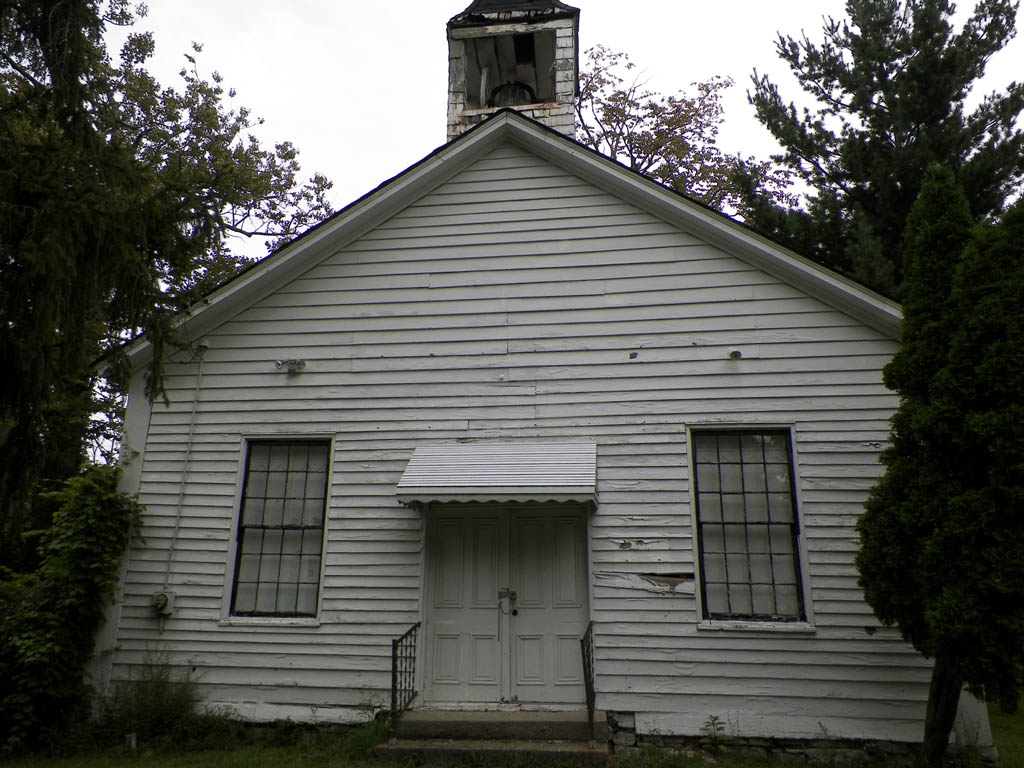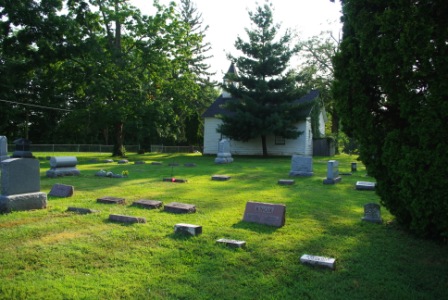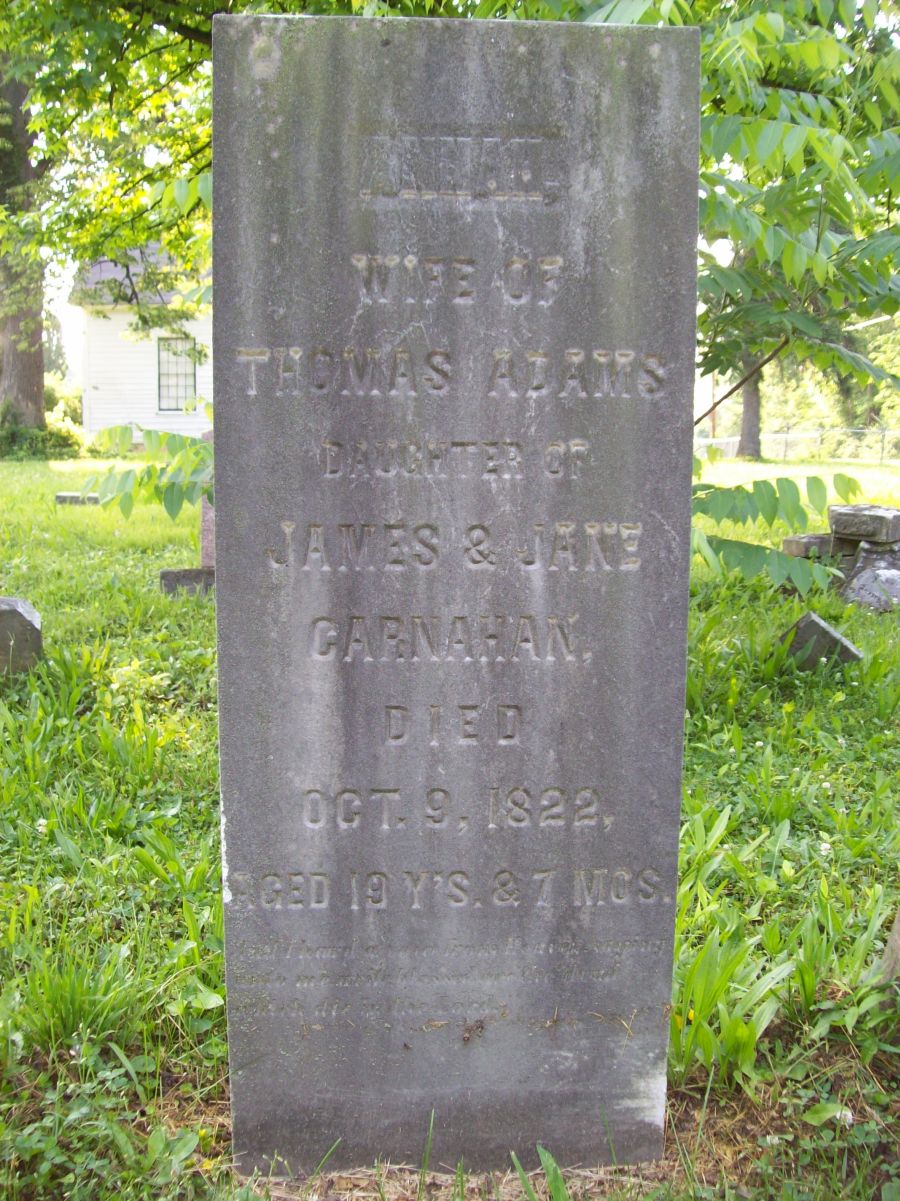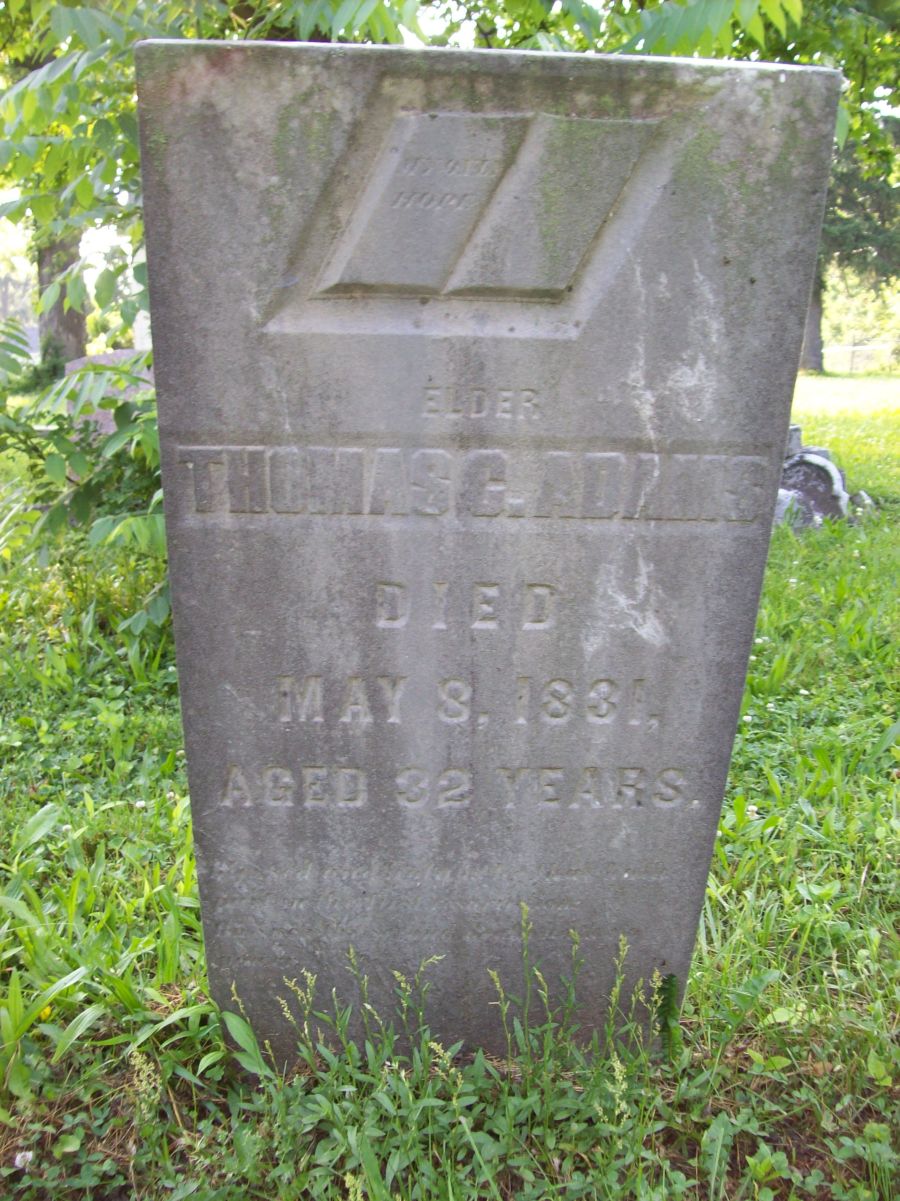Thomas C. Adams
1798-1831
[need photo or likeness]
![]()
Biographical Sketch of Elder Thomas C. Adams
His Father. Birth. Conversion. Impressions to Preach. Difficulties. Ordination.
Marriage. Death of his Wife. His own affliction. His character as a Scholar, Speaker, and in Private Life.
His Death and Burial. Remarks of the Writer.
MAJOR George Adams, the father of Elder Thomas Adams, served in the war against the Indians at the close of the Revolution, and was so badly wounded that his life was dispared(sic) of in the War of 1812, he filled the rank of Major, and commanded the Guards on the frontier of Ohio. He was one of the early settlers in Montgomery County, Ohio. He was an exemplary member of the Christian church.
Elder Thomas Adams was born near Dayton, in the year 1798. He professed the Christian religion, and united with the Christian church when about 16 years of age. His father emigrated and settled again on an entire frontier, in Darke County. The opportunity for educating his family was poor: he was under the necessity of boarding his children from home to school them. In this way Thomas received a limited education. When quite young he became solemnly impressed with the value of souls, and felt it to be his duty to warn sinners "to flee the wrath to come." He had moral courage sufficient to engage in any work that he believed God had called him to. "He conferred not with flesh and blood." but immediately engaged in the all-important work of proclaiming the gospel to the world. He persevered through difficulties that an irresolute mind would never have overcome. His opportunity for improvement had been by no means good. His manner of address was awkward, and his language imperfect, and he spoke just as fast as his tongue could possibly run. Upon the whole, he had nothing to recommend him but his upright deportment and honest zeal. It was a tax on the patience of any person of taste to listen to him. Under these circumstances he met with very little encouragement from his brethren, particularly preachers; some of them treated him with neglect and contempt, but others, believing him to be an honest and devout young man, endeavored to bear him up.
Elder George Shidler once told the writer that he had received more persecution for encouraging Brother Thomas Adams than he ever had from any other quarter in his life. The people became offended at him because he would take him with him and encourage him to speak. But Brother Shidler seemed to rejoice to think that he had borne him up, and had not treated him as many others had done. He then spoke of Brother Adams as being entirely his superior, and appeared to feel himself as a child compared with him. They had traveled one tour together into Pennsylvania. Brother Adams continued humble and devout, and was a constant student of the Bible. It was soon discovered that his mind began to expand, and his manner and language improve. He "studied to show himself approved unto God," and soon became "a workman that needed not to be ashamed." In the summer of 1819, he went back into Pennsylvania in company with his brother George Adams and John Plummer, mid on the 29th day of July he was ordained to the work of the ministry, by the laying on of hands by Elders Isaac McBride and John Plummer, in the Clarksville church. Pa. He afterwards returned to Ohio.
He not only stored his mind with Biblical knowledge, but entered diligently into the pursuit of science. He forsook his rambling course of preaching, and measurably confined his labors to a few churches. In this way it is believed he was more useful, and had a greater opportunity of improving his mind.
In the fall of 1821, he was reduced very low with the fever, and while laboring under this disease, hemorrhage of the lungs supervened to a very alarming extent; from this he partially recovered but ever afterwards appeared disposed to consumption.
He was married on the 22nd day of May, 1822, to Ann Carnahan, daughter of James Carnahan, of Hamilton Co., Ohio. She was an amiable and respectable member of the Christian church. But this happy relation lasted with them but a few months. On the 9th of the following October, she was wrested from his bosom and her affectionate friends by the hand of death, at which time he was lying very low in sickness himself, scarcely able to be taken into her room to bid her farewell. She was interred in the grave-yard at Burlington meeting-house. After his recovery, he continued to preach, and mainly supported himself by teaching school, and assiduously endeavored to store his mind with useful knowledge. He became an able critic in the English language; he also understood the Latin, Greek, and French languages well. His labors were measurably confined to Warren, Butler, and Hamilton counties. Brother Adams is no longer the youth we spoke of at the commencement of this sketch. We find not the boy laboring under almost every embarrassment imaginable.
Reader, in your imagination you may travel as far to the reverse as you reasonably can, and you will not leave him in the rear.
We find him now a perfect gentleman, a profound scholar, an able and logical reasoner, a real philosopher and a beautiful speaker. His language was chaste, his manner agreeable and interesting, his sermons methodical and instructive. If his bodily strength had been sufficient to fully command his voice he would have been one of the most splendid orators of his day. He lived, and preached some in the latter part of his life in Cincinnati, where it is thought he had but few if any rivals. In his private life he was punctual, honest, and obliging. In all his social circles he was pleasant and agreeable, and to cap the climax, he was a Christian in life as well as in profession. He was a great and good man.
While teaching school in the neighborhood of Burlington, Hamilton County, Ohio, he was instrumental in keeping prayer-meetings in the neighborhood. A very remarkable religious revival took place, in which a goodly number professed the Christian religion, among whom were several talented young men who afterwards became eminent ministers of the Gospel of Christ. Wherever he went he showed himself a pattern of good works.
Notwithstanding all this, disease and death (which do not respect any person) called him away from labor to reward in the midst of his days. He suffered for about ten years under a pulmonary consumption, and died in Lexington, Kentucky, on the 8th day of May, 1831, in the 34th year of his age. He was buried in Lexington. Some years afterwards his friends had his remains removed and interred beside his wife in Hamilton County. Ohio.
The writer was well acquainted with Elder Thomas Adams. He believes the foregoing to be strictly correct: much more might be said in his praise. The writer has a hope that this sketch will be of some benefit.
First, from the example of Brother Adams, let young men who are conscious that it is their duty to improve their gift in public, be faithful, persevering, studious, humble, devout, prayerful, and exemplary, and the God of heaven will bless them and make them a blessing to others.
In the second place, let it be a caution to the brethren, particularly the preachers, never to put any discouragement in the way of young preachers, "lest haply they be found even to fight against God."
What must have been the feelings of those brethren, who discountenanced Brother Adams in the commencement of his ministerial labors, when they beheld the latent powers of his mind developed? and heard him with feelings of deep respect? and had to acknowledge his superior rhetorical powers? He occupied his talents until they increased to more than ten: while many with better opportunities buried theirs in the earth, and even what they once had appeared to be taken from them.-Levi Purviance, Biography of David Purviance, Appendix, Chapter 8, pages 217-220
![]()
Thomas Adams
1798-1831
The subject of this sketch was the son of Major George Adams, who served with distinction in the American Revolution. Thomas was born in Montgomery County, O., in 1798. At the age of sixteen, he embraced religion, and not long after, began to speak in public.
His manner, at first, was so unattractive to his hearers that many discouraged him from preaching ; but Elder George Shidler and others held him up, till, by practice and a liberal education, which he acquired after his first labors in the ministry, he became a good orator and an attractive speaker. In 1821, he had a severe attack of fever together with a hemorrhage of the lungs, from which he never fully recovered.
In May, 1822, he was married to Miss Ann Carnahan, who died a few months afterwards—a great shock to the young husband. She was buried in the Burlington church-yard, where, in a few years, the body of her husband was laid by her side. His health failed rapidly after this period. When his wife was dying, he could hardly leave his bed to bid her farewell. For a while, however, he recovered, and accomplished much as minister and school teacher. He was a hard student, doing nothing by halves, but probing every subject to the bottom. The name of Thomas Adams stands high with the people of Hamilton County, 0., where he spent much of his time, not only as an able preacher and a thorough scholar, but as a devoted, humble, and faithful Christian man.
He died in Lexington, Ky., of consumption, May 8, 18-31, aged thirty-four years.
-bio in Memoirs of Deceased Ministers, E.W. Humphreys, c.1880, p.11,12
![]()
Directions To The Grave of Thomas C. Adams
T.C. Adams is buried in the Carnahan family plot in the New Burlington church cemetery in Hamilton County, Ohio. As it is in the north Cincinnati area, directions could be given from several different approaches. Perhaps the best approach would be from the closest interstate. Take the I-275 loop to Exit 36/Hamilton Ave/Hwy. 127., and head toward the city (south). Go a couple of miles and turn left on Springdale Road. The cemetery is on the north corner of Springdale Rd. and W. Mill Rd. There was an old church there. It is my understanding that this property was one of the earliest Christian church locations in the Restoration Movement in Cincinnati. Thus, many who are buried here were New Testament Christians. Only eternity will show the good that was accomplished here. One of the preachers of this church was John Hardy, who is buried up in Preble County, near Eaton and Dayton. The actual location of the grave of Thomas Adams is noted below in the GPS location. Also buried in this cemetery is minister, William Kincade.
GPS Location
39°15'43.6"N 84°32'51.1"W
or D.d. 39.262122, -84.547517
![]()
Photo of Original Building
No longer extant as of 2024

Courtesy of Alicia Beauchamp (Find-A-Grave)
This building no longer exists (2024)

Courtesy of Donald Shull (Find-A-Grave)

Annah
wife of Thomas Adams
daughter of James & Jane Carnahan
died Oct 9, 1822
aged 19 y's & 7 mos
(writing below illegible)

Elder Thomas C. Adams
died May 8, 1831
aged 32 years
(writing below illegible)
![]()
Photos from June, 2024
![]()
Photos Courtesy of Todd Walker (find-a-grave), taken May, 2012
Site built 10.12.2012
Webmaster Note: I finally had an opportunity to visit the Old Burlington Church cemetery and the grave of restoration preacher, Thomas Adams in June, 2024. I was on a Restoration work trip hosted by Polishing The Pulpit. Making my way to Bethany, WV, from Cane Ridge, KY, I had the opportunity to travel through Cincinnati when I took the time to head over to the western side of the city to find the grave of Thomas Adams. Also buried in the cemetery here, and very near the Adams plot is the grave of another Restoration Movement preacher, William Kincade.
Courtesy of Scott Harp
www.TheRestorationMovement.com
![]()




